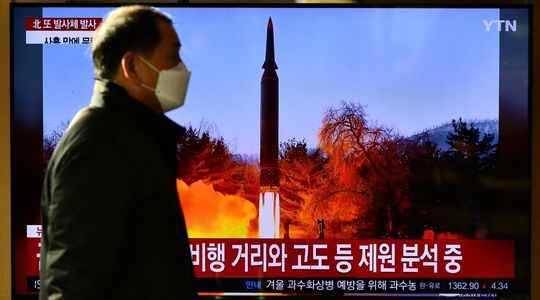In January, the weeks pass and look strangely alike. At least for North Korea. Kim Jong-un’s regime conducted its sixth missile test launch this year on Thursday, according to South Korea’s Joint Chiefs of Staff. The previous firings – two cruise missile tests – date from Tuesday. North Korea also announced that it had tested hypersonic (January 5 and 11) and ballistic (January 14 and 17) missiles. The last time the country showed so much muscle in a month was in 2019, after negotiations between Kim Jong-un and Donald Trump, then President of the United States, broke down.
In the wake of the announcement of the firing of missiles presented as hypersonic – whose targets and trajectories can be modified in flight – Washington had imposed new financial sanctions against five North Korean nationals.
These new tests by Pyongyang would be interpreted as a response to US sanctions, with the aim of “reducing the sanctions”, analyzes Pierre Rigoulot, historian and author of To put an end to North Korea (2018, Ed. Buchet-Chastel). All in a particular regional context: China, an interlocutor of the North Korean regime, hosts the Winter Olympics in February, and South Korea must elect its president in early March.
L’Express: How can this renewed missile fire by North Korea be explained?
Pierre Rigoulot: I have no precise explanation for this rather brutal acceleration compared to the previous months. But this is part of a general progression that has been going on for several years, with more intense periods and others, moreover, calmer. These trials can be interpreted as a North Korean method – that of showing the muscles – to reduce the sanctions. To prove that they do not have the expected effects, since North Korea is still producing, is increasing its ballistic capacity. And that, in fact, the latter will weigh more heavily during the negotiations.
Do these trials allow the regime to mobilize its population in a context of food shortage or, precisely, to bring the United States back to the negotiating table? Or both ?
North Korea is in a kind of mechanism already encountered before with other small totalitarian states, which armed themselves from head to toe to have enough to repel all possible aggressors, but whose regime ended up falling from the interior. There is a double logic: you don’t know how to feed your population but you know how to build weapons very well. I am not sure that the population has a say in the development of missiles, which will not make it possible to solve the food problem, the origin of which comes from the very nature of the regime, from its way of seeing the world. So it would rather be a question of having an effect on the negotiations with the United States, if indeed they are indeed interrupted. The United States wants North Korea to end its nuclear arsenal; North Korea, whose point of view is very distant on the question, would rather seek a reduction in sanctions.
Can we expect more North Korean trials soon?
It’s a machine in place, with its own logic, and I don’t see how it could be stopped. It seems to be saying that there could be a “gunners’ truce”: that neither the Russians over Ukraine nor the North Koreans with their missiles will do anything to annoy China, which is hosting the Winter Olympics . I’m not sure that’s true. It’s hard to say anything with a regime locked behind thick walls.
